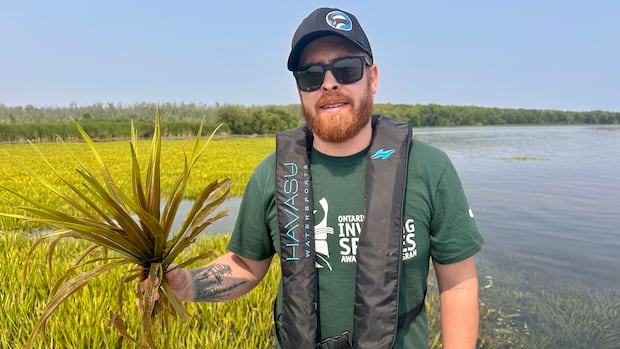Experts say invasive plant in Lake Simcoe can injure swimmers, harm the environment
Water soldier working group surveying the area, planning for control and treatment
Experts are warning about the harmful impacts of an invasive aquatic plant in Lake Simcoe, nearly 100 kilometres north of Toronto.
Water soldier is not new to the province, but it was spotted for the first time in Lake Simcoe last year. The perennial aquatic plant is prohibited under Ontario's Invasive Species Act.
The plant has long, thin, serrated leaves that grow in a circular pattern, according to the Invasive Species Centre, a non-profit. The plant forms dense mats that crowd out other vegetation and may alter water chemistry, impacting native aquatic species.
Water soldier can be submerged up to five metres under water but floats to the surface in the summer.
"It will cut you up if you handle the plant or try to swim around the plant. So what we're trying to do is mitigate its spread," said Brook Schryer, an advisor for the Invading Species Awareness Program with the Ontario Federation of Anglers and Hunters Foundation.
Water soldier is used as an ornamental plant in water gardens, the likely source of its introduction to the province, according to the Ministry of Natural Resources.
"This plant is a severe risk to recreational activities and it's a threat to wildlife such as fishes, waterfowl and migratory birds," Schryer said, noting the potential impact to the economy as well.
Members of the water soldier working group quickly mobilized to survey the area when it was first spotted. The group includes government officials, Indigenous organizations, conservation authorities, and other environmental groups.
To date, surveys have shown the infestation to be limited to Cook's Bay, but the worry is that it will spread to other areas of Lake Simcoe.
Right now the work being done is focused on evaluating the extent of this invasion, according to the province, and next steps will be managing plans for control and treatment.
Judy Dwyer's property backs onto the lake, and the plant is already impacting her. She said she will wear gloves and pull the plants that are nearby her dock, but they come back quickly.
"I haven't swam this year. And I have grandchildren and I'd love for the kids to swim in the water, but I don't want them to now," Dwyer said.
Schryer says there has been a lot of support from various government agencies, but he hopes to see more funding from the federal government to help tackle the issue.
"I've been working on aquatic invasive species for 10 years and you know, given the economy and user base of Lake Simcoe, this is probably of top priority," Schryer said.
In an emailed statement from Fisheries and Oceans Canada, a spokesperson said invasive species are a shared responsibility across federal, provincial and territorial governments.
"In the case of aquatic invasive plants, such as Water Soldier, the government of Ontario, in collaboration with the municipalities, is responsible for the management of waterways within their jurisdiction," said Mike Campbell in the statement.
He said the federal government is part of a working group that collaborates to control the spread of water soldier within the Trent-Severn Waterway and helps fund Ontario-based projects to prevent the spread of invasive aquatic species.
How residents can help
In the few other areas of the province with water soldier, it's been extremely challenging to handle, says Colin Cassin, executive director of the Invasive Species Centre.
"Just getting the boat in and out, a canoe, kayak, just swimming off the dock or off the sandy beach, it can really impede how we use our lakes," he said, adding that residents can also do their part to help.
"It looks like the top of a pineapple or a household spider plant," Cassin said.
"If you see something like that floating in the water, especially in Lake Simcoe, the best thing you can do is report it."
Experts recommend residents learn how to identify the plant and report the sightings though the invading species hotline (1-800-563-7711) or the EDDmapS website.



